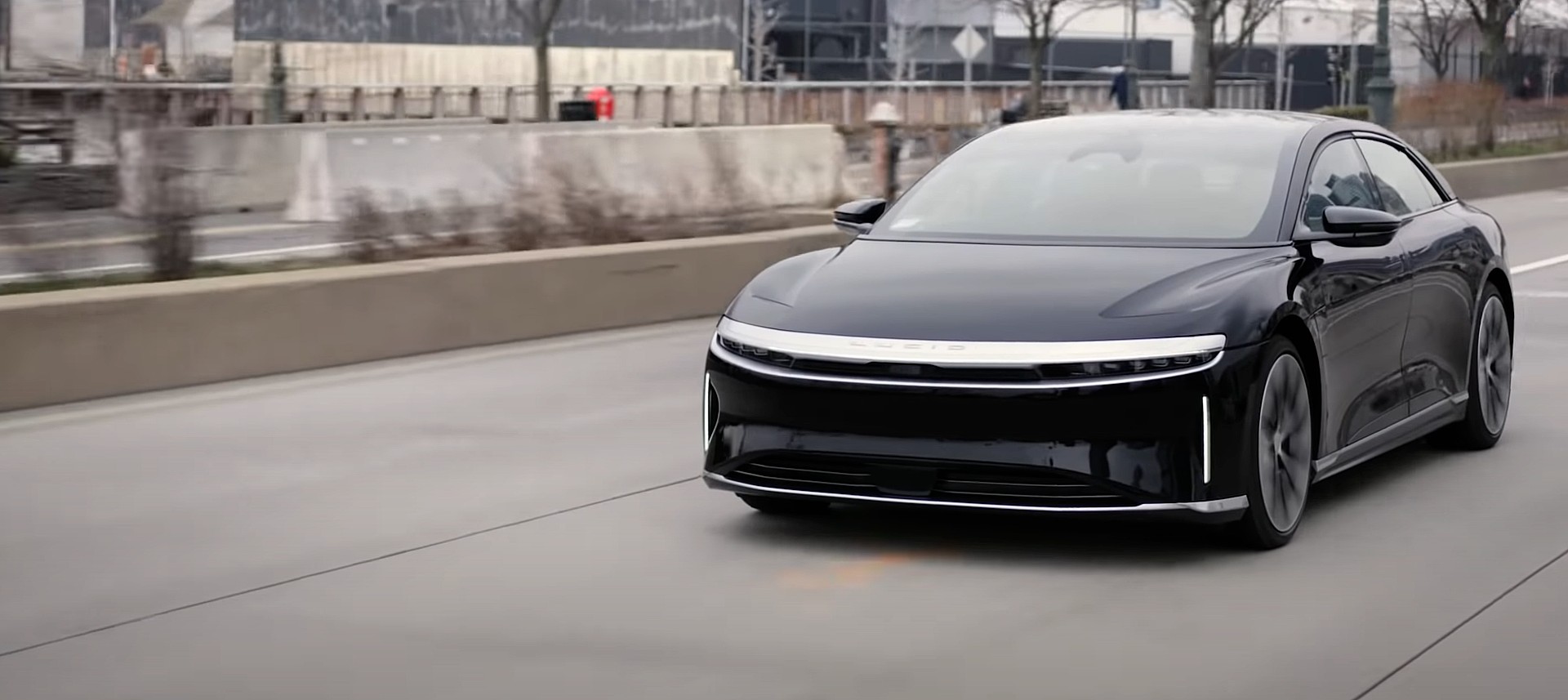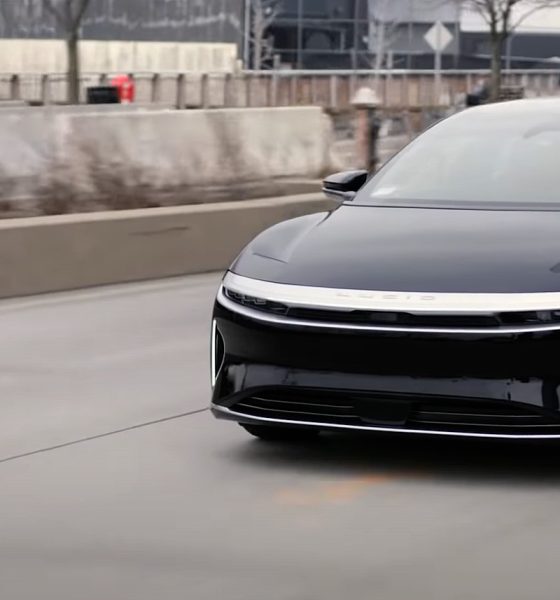Lucid Motors’ introductory all-electric vehicle, the Air, is primed for imminent release that is set to occur later this year. Until then, Lucid is refining the details that set the Air apart from its competitors, and its CEO Peter Rawlinson is also getting his hands dirty. Recently, he took the Air to Manhattan in New York City to test the vehicle’s performance in sleek, slender, and challenging urban settings. One thing is for sure, this luxury sedan from Lucid is set to be a disruptive force in the electric sector as it packs performance with comfortability in all the right ways. Rawlinson was sure to complement his company’s first production EV, but he also was vocal about some minor changes he’d like to see ahead of its initial deliveries.
Rawlinson started his trip through Manhattan on a stroll that took him down the Hudson River to the Financial District. After getting perfect views of One World Trade Center and lower Manhattan, Rawlinson continued his trek through the City that Never Sleeps, highlighting several changes that the Lucid team made to the Air’s design. Everything from pillars that created blind spots to the quality of the instrument panel buttons was broken down by Rawlinson, who has held a high standard for his company’s vehicles ever since they have been introduced prior to their production.
An all-too-common narrative that has been projected among the EV community is that of what company will change the game once again. While Tesla technically introduced the electric vehicle sector to the average car buyer, other companies are coming in to create competition and innovation. Lucid is just one of many, but their approach to the electric car is completely different from its competitors. While many are looking years into the future and how the “big picture” of the automotive industry is inevitably set for a massive change in the coming years, Lucid is focused on the short-term.
Rawlinson’s goal is to begin putting cars on the road as soon as possible, and it begins with ending the narrative that Lucid has accomplished something when it hasn’t yet delivered a car. “We are nothing until we’ve got anything into production,” Rawlinson once said, highlighting his inkling for a vehicle delivery by the end of 2021.
The hands-on approach that Rawlinson has taken is eerily similar to that of his former boss Elon Musk. The two worked together in the early 2010s while the development of the Model S was underway. Small, contested, and stressful car startups are becoming more frequent, and Rawlinson has already done this once before. It takes attention to detail from a crafty automotive veteran to ensure that things go smoothly, and Rawlinson may be the perfect man for the job. While he could be sitting in his ritzy office in California, he is instead taking his company’s first car and navigating it through some of the world’s busiest streets, working on perfecting the Lucid Air months before it begins arriving to customers.
Lucid’s premier Air Dream Edition will begin deliveries later this year. While the company will build 500 Air Dream Edition variants, it has three other configurations that will be available in the coming months. Ultimately, Lucid’s big plan is relatable to Tesla’s Master Plan: build an expensive luxury vehicle, and use the funds from that to develop new, affordable, all-electric powertrains in the coming years.
Watch Lucid CEO and CTO Peter Rawlinson take the Lucid Air through the streets of Manhattan below.

News
Tesla FSD fleet is nearing 7 billion total miles, including 2.5 billion city miles
As can be seen on Tesla’s official FSD webpage, vehicles equipped with the system have now navigated over 6.99 billion miles.

Tesla’s Full Self-Driving (Supervised) fleet is closing in on almost 7 billion total miles driven, as per data posted by the company on its official FSD webpage.
These figures hint at the massive scale of data fueling Tesla’s rapid FSD improvements, which have been quite notable as of late.
FSD mileage milestones
As can be seen on Tesla’s official FSD webpage, vehicles equipped with the system have now navigated over 6.99 billion miles. Tesla owner and avid FSD tester Whole Mars Catalog also shared a screenshot indicating that from the nearly 7 billion miles traveled by the FSD fleet, more than 2.5 billion miles were driven inside cities.
City miles are particularly valuable for complex urban scenarios like unprotected turns, pedestrian interactions, and traffic lights. This is also the difference-maker for FSD, as only complex solutions, such as Waymo’s self-driving taxis, operate similarly on inner-city streets. And even then, incidents such as the San Francisco blackouts have proven challenging for sensor-rich vehicles like Waymos.
Tesla’s data edge
Tesla has a number of advantages in the autonomous vehicle sector, one of which is the size of its fleet and the number of vehicles training FSD on real-world roads. Tesla’s nearly 7 billion FSD miles then allow the company to roll out updates that make its vehicles behave like they are being driven by experienced drivers, even if they are operating on their own.
So notable are Tesla’s improvements to FSD that NVIDIA Director of Robotics Jim Fan, after experiencing FSD v14, noted that the system is the first AI that passes what he described as a “Physical Turing Test.”
“Despite knowing exactly how robot learning works, I still find it magical watching the steering wheel turn by itself. First it feels surreal, next it becomes routine. Then, like the smartphone, taking it away actively hurts. This is how humanity gets rewired and glued to god-like technologies,” Fan wrote in a post on X.
News
Tesla starts showing how FSD will change lives in Europe
Local officials tested the system on narrow country roads and were impressed by FSD’s smooth, human-like driving, with some calling the service a game-changer for everyday life in areas that are far from urban centers.

Tesla has launched Europe’s first public shuttle service using Full Self-Driving (Supervised) in the rural Eifelkreis Bitburg-Prüm region of Germany, demonstrating how the technology can restore independence and mobility for people who struggle with limited transport options.
Local officials tested the system on narrow country roads and were impressed by FSD’s smooth, human-like driving, with some calling the service a game-changer for everyday life in areas that are far from urban centers.
Officials see real impact on rural residents
Arzfeld Mayor Johannes Kuhl and District Administrator Andreas Kruppert personally tested the Tesla shuttle service. This allowed them to see just how well FSD navigated winding lanes and rural roads confidently. Kruppert said, “Autonomous driving sounds like science fiction to many, but we simply see here that it works totally well in rural regions too.” Kuhl, for his part, also noted that FSD “feels like a very experienced driver.”
The pilot complements the area’s “Citizen Bus” program, which provides on-demand rides for elderly residents who can no longer drive themselves. Tesla Europe shared a video of a demonstration of the service, highlighting how FSD gives people their freedom back, even in places where public transport is not as prevalent.
What the Ministry for Economic Affairs and Transport says
Rhineland-Palatinate’s Minister Daniela Schmitt supported the project, praising the collaboration that made this “first of its kind in Europe” possible. As per the ministry, the rural rollout for the service shows FSD’s potential beyond major cities, and it delivers tangible benefits like grocery runs, doctor visits, and social connections for isolated residents.
“Reliable and flexible mobility is especially vital in rural areas. With the launch of a shuttle service using self-driving vehicles (FSD supervised) by Tesla in the Eifelkreis Bitburg-Prüm, an innovative pilot project is now getting underway that complements local community bus services. It is the first project of its kind in Europe.
“The result is a real gain for rural mobility: greater accessibility, more flexibility and tangible benefits for everyday life. A strong signal for innovation, cooperation and future-oriented mobility beyond urban centers,” the ministry wrote in a LinkedIn post.
News
Tesla China quietly posts Robotaxi-related job listing
Tesla China is currently seeking a Low Voltage Electrical Engineer to work on circuit board design for the company’s autonomous vehicles.

Tesla has posted a new job listing in Shanghai explicitly tied to its Robotaxi program, fueling speculation that the company is preparing to launch its dedicated autonomous ride-hailing service in China.
As noted in the listing, Tesla China is currently seeking a Low Voltage Electrical Engineer to work on circuit board design for the company’s autonomous vehicles.
Robotaxi-specific role
The listing, which was shared on social media platform X by industry watcher @tslaming, suggested that Tesla China is looking to fill the role urgently. The job listing itself specifically mentions that the person hired for the role will be working on the Low Voltage Hardware team, which would design the circuit boards that would serve as the nervous system of the Robotaxi.
Key tasks for the role, as indicated in the job listing, include collaboration with PCB layout, firmware, mechanical, program management, and validation teams, among other responsibilities. The role is based in Shanghai.
China Robotaxi launch
China represents a massive potential market for robotaxis, with its dense urban centers and supportive policies in select cities. Tesla has limited permission to roll out FSD in the country, though despite this, its vehicles have been hailed as among the best in the market when it comes to autonomous features. So far, at least, it appears that China supports Tesla’s FSD and Robotaxi rollout.
This was hinted at in November, when Tesla brought the Cybercab to the 8th China International Import Expo (CIIE) in Shanghai, marking the first time that the autonomous two-seater was brought to the Asia-Pacific region. The vehicle, despite not having a release date in China, received a significant amount of interest among the event’s attendees.










